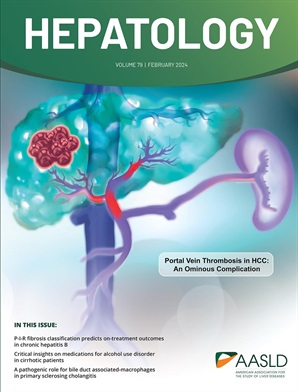胆汁盐输出泵(BSEP)缺乏症患者预处理血清胆汁酸组成及对奥维西他后续反应的可预测性
IF 12.9
1区 医学
Q1 GASTROENTEROLOGY & HEPATOLOGY
引用次数: 0
摘要
背景,目的:胆汁盐输出泵(BSEP)缺乏症,或进行性家族性肝内胆汁淤积2型,是一种以胆汁酸分泌缺陷为特征的遗传性肝病。Odevixibat是一种回肠胆汁酸转运抑制剂(IBATi),可损害共轭胆汁酸的肠重吸收,降低一些BSEP缺乏患者的血清胆汁酸(sBA)浓度。我们评估了预处理sBA水平与BSEP缺乏症患者组成的关系,以及随后对奥维西坦的反应,以提高我们对其机制的理解。的方法,结果:在这项盲法事后分析中,使用液相色谱-串联质谱法分析了41名接受奥维昔巴治疗的参与PEDFIC的BSEP缺乏症患者的预处理sBAs。患者分为sBA应答者(Rs)和无应答者(nr)。评估预处理个体sBAs与后续反应的相关性,并构建受试者工作特征(ROC)曲线以确定判别临界值。非共轭胆酸(CA)预处理比例较高;ROC曲线下面积[AUC]: 0.70 [95% CI: 0.52-0.87;P=0.03]),非共轭鹅去氧胆酸(CDCA;Auc: 0.73 [0.56-0.90];P=0.01), CA + CDCA浓度(AUC: 0.76 [0.61 ~ 0.92];P = 0.001)。当达到3个临界值中的≥1个时,36/41 (87.8%)BSEP缺乏患者被正确归类为后续Rs (17/19;敏感性:89.5%)或NRs (19/22;特异性:86.4%)。结论:较高的预处理血清非共轭CA和CDCA水平与BSEP缺乏症患者随后对奥维西坦的反应相关。对奥维西坦的反应可能与BSEP缺乏患者的剩余胆汁酸分泌能力有关。本文章由计算机程序翻译,如有差异,请以英文原文为准。
Pretreatment serum bile acid composition and predictability of subsequent response to odevixibat in patients with bile salt export pump (BSEP) deficiency
Background & Aims: Bile salt export pump (BSEP) deficiency, or progressive familial intrahepatic cholestasis type 2, is a genetic liver disease characterized by defective biliary bile acid secretion. Odevixibat, an ileal bile acid transporter inhibitor (IBATi), impairs intestinal reabsorption of conjugated bile acids, reducing serum bile acid (sBA) concentration in some patients with BSEP deficiency. We evaluated association of pretreatment sBA levels and composition, and subsequent response to odevixibat in patients with BSEP deficiency to improve our understanding of the mechanism. Approach & Results: In this blinded post hoc analysis, pretreatment sBAs from 41 odevixibat-treated patients with BSEP deficiency who participated in PEDFIC were analyzed using liquid chromatography-tandem mass spectrometry. Patients were divided into sBA responders (Rs) and non-responders (NRs). Association of pretreatment individual sBAs with subsequent response was evaluated and receiver operating characteristic (ROC) curves were constructed to identify discriminating cutoff values. Rs had higher pretreatment percentages of unconjugated cholic acid (CA; area under the ROC curve [AUC]: 0.70 [95% CI: 0.52–0.87; P =0.03]), unconjugated chenodeoxycholic acid (CDCA; AUC: 0.73 [0.56–0.90]; P =0.01), and concentration of CA + CDCA (AUC: 0.76 [0.61–0.92]; P =0.001). When ≥1 of 3 cutoffs were reached, 36/41 (87.8%) patients with BSEP deficiency were correctly classified as subsequent Rs (17/19; sensitivity: 89.5%) or NRs (19/22; specificity: 86.4%). Conclusions: Higher pretreatment serum levels of unconjugated CA and CDCA are associated with subsequent response to odevixibat in patients with BSEP deficiency. Response to odevixibat may be related to residual biliary bile acid secretion capacity in patients with BSEP deficiency.
求助全文
通过发布文献求助,成功后即可免费获取论文全文。
去求助
来源期刊

Hepatology
医学-胃肠肝病学
CiteScore
27.50
自引率
3.70%
发文量
609
审稿时长
1 months
期刊介绍:
HEPATOLOGY is recognized as the leading publication in the field of liver disease. It features original, peer-reviewed articles covering various aspects of liver structure, function, and disease. The journal's distinguished Editorial Board carefully selects the best articles each month, focusing on topics including immunology, chronic hepatitis, viral hepatitis, cirrhosis, genetic and metabolic liver diseases, liver cancer, and drug metabolism.
 求助内容:
求助内容: 应助结果提醒方式:
应助结果提醒方式:


